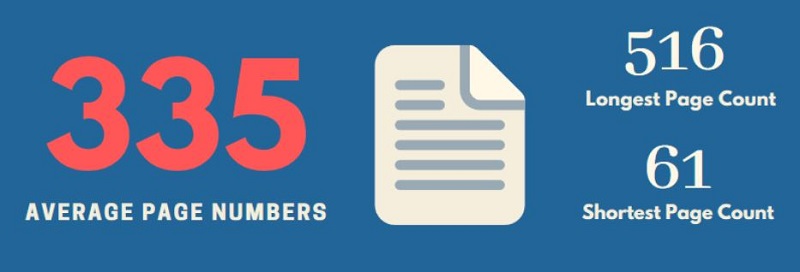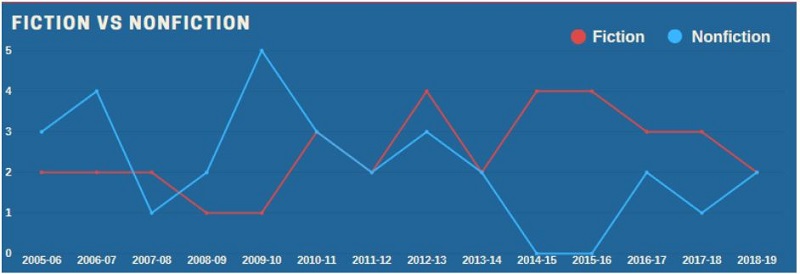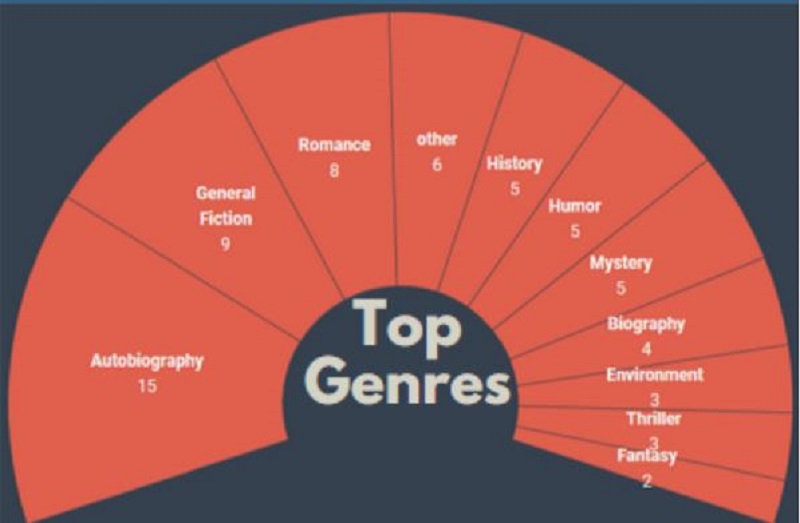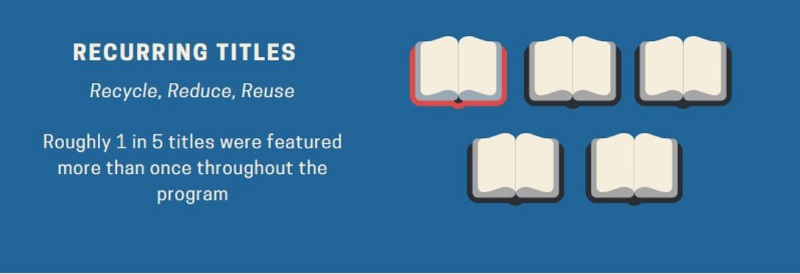University Libraries

Porch Reads at 14: By the Numbers
By Matt McKinley
- Editor's note: Porch Reads, a popular leisure reading program founded in 2005, was originally funded with an "Enhancing Student Culture for Academic Engagement and Excellence" grant. Ongoing support has been provided by donations and a generous endowment established for the program.
With Roesch Library in the process of “refreshing,” there has never been a better time for Porch Reads to take advantage of the positive inertia and get some spring cleaning done. My recent file reorganization efforts afforded me the opportunity to take stock of the entire collection of titles featured over the past 14 years. What resulted was a deep dive into annals of the Porch Reads team drive, where I have unearthed program facts and figures long buried in time and metaphorical dust.
Porch Reads was founded in the fall of 2005 with the intention of encouraging students to take a break from reading just for study and to instead read for enjoyment and personal fulfillment. The first session featured America (The Book): A Citizen's Guide to Democracy Inaction by Jon Stewart and the writers of The Daily Show with Jon Stewart — and drew an eager group of bibliophiles to discuss their thoughts on the book over pizza.(1) With the implementation of the PATH program in 2014, undergraduates were able to earn highly desirable housing points by participating in the program.
By the numbers
Tracking the history of Porch Reads titles gave me a chance to dive into the numbers and discover some interesting aspects on the history of the program. Recent humanities scholarship has looked at literary output in the same way but on a much larger scale. In Graphs, Maps,Trees: Abstract Models for Literary History (2), Italian literary scholar Franco Moretti examined the quantitative history of the novel, in which he studies world literature not by closely reading it, but by counting it. Moretti’s study provides tables, charts and maps depicting the abstract interactions between production, publishing, authorship and genre in relation to historical context. Work like Moretti’s and technological developments in the realm of being able to analyze large datasets, i.e. big data, made way for a more rigorous digital study of the humanities.(3)
I find this methodology of distantly surveying literature inspiring and have been looking for an excuse to try something similar for a while now. And even though these scholars tend to cover much broader subjects with much larger datasets, I thought it would be interesting to micro-focus on the brief but compelling history of books featured by Porch Reads. After some data entry and processing, I was able to compile several visualizations that help to display the program’s history in an abstract sense.
What can a quantified history of an extracurricular book club tell us? Although the titles are curated by librarians, their popularity and current cultural relevance most certainly is taken into consideration. The list almost always includes bestsellers and well-known novels that have been adapted into feature films. These selections provide a snapshot of cultural influence in a particular time and place.
Fiction vs. Nonfiction
One of the first data points I looked at was the occurrence of fiction titles versus nonfiction by academic year. I compiled a line graph to best depict the ebb and flow of fiction versus nonfiction titles over time. Nonfiction titles seem to have mostly led the first half of the program; in 2012, fiction began to pull ahead (see graphic in gallery).
Pages
The books averaged 335 pages (see graphic in gallery). The record for the longest book in the history of the program goes to Erin Morgenstern’s Night Circus, which came in at 516 pages; the shortest was The Grownup by Gillian Flynn at a mere 61 pages. And in case you were wondering, if you were to read every book in the Porch Reads collection, it would total a whopping 11,630 pages.
genres
For both PATH-eligible and non-PATH-eligible discussions, the exploration of authorship remains a core objective of the Porch Reads program. It’s no wonder, then, that the most prominent genre in the program happens to be autobiographies, which convey the authors’ experiences in their own words.
Romance appears to be the highest-occurring specified fictional genre, but overall, the collection displays a fairly broad representation of genres on a steady, gradual slope (see graphic in gallery).
- Autobiography (15)
- General fiction (9)
- Romance (8)
- Other (6)
- History (5)
- Humor (5)
- Mystery (5)
- Biography (4)
- Environment (3)
- Thriller (3)
- Fantasy (2)
Recurring titles
Around one in every five titles was featured more than once. Repeats could be due to a surplus of physical copies, cultural buzz or an extended sign of interest from readers who were unable to attend the first session. Some books, however, might simply have some sort of mystical staying power. Mark Haddon’s The Curious Incident of the Dog in the Night-Time “curiously" appeared three times over the course of eight academic years between 2005-06 and 2012-13.
Authors
Nick Hornby takes the record for most-read author, appearing in five different terms. But if we are only counting unique titles and not repeats, then Gillian Flynn and Nick Hornby would both be tied at three (see graphic in gallery).
Outcomes
Providing our students with a range of perspectives aligns directly with the University’s mission to educate the whole student. PATH articulates that the goal of authorship as a learning outcome is to “engage others to identify personal values and spiritual identity” and “demonstrate respect and appreciation of others’ perspectives.” Feedback from students on surveys within the last few years indicates that Porch Reads can provide this kind of engagement. When asked what they have learned from each book talk, participants responded, “[a] lot about historical context & perspective” and, “even as different people, we can still share similar struggles”.
Stay tuned for future Porch Reads book talks, which will resume this fall.
Titles
Browse a complete list of Porch Reads titles.
Notes
For more information on the Porch Reads beginnings, see Gauder, H., J. Giglierano, and C. Schramm (2007). Porch Reads: Encouraging recreational reading among college students. College & Undergraduate Libraries, 14(2), 1-24. https://ecommons.udayton.edu/roesch_fac/16
Moretti, Franco. "Graphs, Maps, Trees - 1." New Left Review, no. 24 (November 2003): 67-93. Accessed April 29, 2019. https://newleftreview.org/issues/II24/articles/franco-moretti-graphs-maps-trees-1
Jenkins, Jeff. “Digital Humanities (DH).” Salem Press Encyclopedia, 2019. http://libproxy.udayton.edu/login?url=https://search.ebscohost.com/login.aspx?direct=true&db=ers&AN=133860736&site=eds-live
― Matt McKinley is a research services assistant in the University Libraries.




